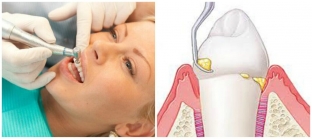Tartar is the deposit of plaque of a dense consistency, which has a brownish-yellowish color, is localized on the roots and neck of the tooth. Tartar is manifested by unpleasant symptoms that cause a lot of discomfort to the patient. This is the reason for going to the dentist. In addition to sensations, tartar is the cause of a cosmetic defect. The presence of tartar can contribute to the development of many pathological processes in the oral cavity. Let us consider in more detail the causes and mechanism of development of tartar in our article.
What is tartar? Mechanism and causes of tartar formation
Plaque forms solid masses on the surface of the teeth. This occurs as a result of the action of saliva substances on food debris and the activity of various microorganisms in the oral cavity. It has been established that tartar is formed even in people who brush their teeth daily, following all the rules. Therefore, to prevent the formation of tartar, it is important to have regular professional oral hygiene.
Tartar, in addition to plaque, includes mucus, desquamated epithelial cells and microorganisms. Over time, plaque becomes harder, becoming darker due to the content of calcium and iron salts in it, coloring substances in food also give color to tartar.
It has been established that 80% of adults have tartar. Absolutely every person is subject to his education.
But there are reasons and factors that increase the likelihood and increase the rate of tartar formation.
Causes of tartar formation:
- salt metabolism disorder;
- Untimely change of toothbrushes;
- chew food on one side;
- use of poor quality toothpastes;
- the predominance of soft foods in the diet, which disrupts the self-cleaning process of the teeth;
- change in saliva composition;
- diseases of the gastrointestinal tract;
- metabolic disorders;
- long-term use of antibacterial drugs;
- individual features (insufficiently smooth surface, incorrect position of teeth);
- Smoking.

Which places are more likely to develop tartar?
Tartar first appears on the neck of the tooth, later moving to the crown and root of the tooth. If hygiene rules are not followed, tartar can form not only on teeth, but also on dentures.
Tartar builds up in places that are difficult to clean, and in places that cannot be self-cleaned by chewing, as well as in places where microorganisms accumulate.
Tartar takes 4 to 6 months to form, after which it spreads further. The distribution of tartar depends on the individual characteristics of the organism.
Currently, tartar has become more frequently diagnosed in children and adolescents, although earlier it was detected only in adults. This is due to improper, insufficient oral hygiene, the problem of children's smoking, as well as food that is harmful to teeth (sweets, coffee and strong tea).







Add a comment